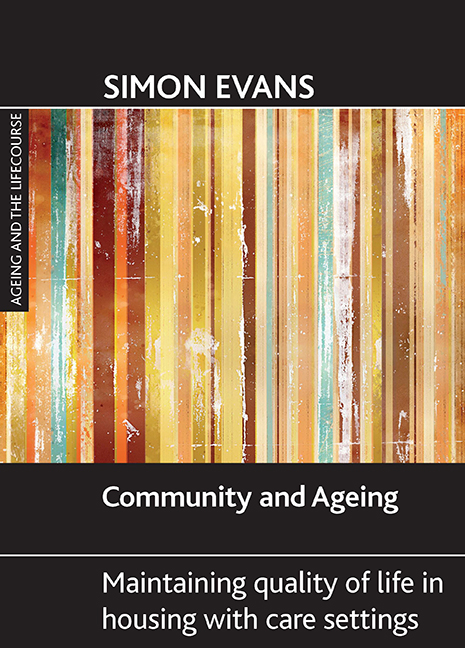Book contents
- Frontmatter
- Contents
- List of tables, boxes and photos
- Acknowledgements
- Foreword
- one Introduction
- two What is community?
- three Community and ageing
- four Housing with care communities in the UK
- five An international perspective on retirement villages
- six Promoting a sense of community in housing with care settings
- seven Diversity, community and social interaction
- eight Changing communities and older people
- nine Conclusion
- Appendix
- References
- Index
- Frontmatter
- Contents
- List of tables, boxes and photos
- Acknowledgements
- Foreword
- one Introduction
- two What is community?
- three Community and ageing
- four Housing with care communities in the UK
- five An international perspective on retirement villages
- six Promoting a sense of community in housing with care settings
- seven Diversity, community and social interaction
- eight Changing communities and older people
- nine Conclusion
- Appendix
- References
- Index
Summary
Introduction
The concept of ‘community’ has always featured strongly in the development of culture and society. Many writers have lamented the passing of the ‘idyllic’ rural-style community and its replacement with the discord and divisions that are perceived to be prevalent in present-day urban living. This chapter explores definitions and theories of community and how they have changed. For example, while early commentators focused on the role of place in a sense of community, some theorists now see communities of interest as more predominant and suggest that kinship has become less important than broader social networks. At the same time, strong communities based on religious identity are emerging, and globalisation has led to social identities becoming blurred and less rooted in physical places.
The impact of government policy on community is also considered, particularly in light of the recent emphasis on promoting community engagement for older people as an important element in quality of life and wellbeing. For example, in the last four years the government has required local authorities to develop community strategies, published a White Paper entitled ‘Strong and Prosperous Communities’ (Department for Communities and Local Government (DCLG), 2006), launched its Sustainable Communities plan and created the post of minister for community cohesion. Community, it would seem, is firmly back at the top of the agenda.
What is ‘community’?
Unless you are a hermit you probably feel part of at least one community and quite possibly several. In fact, even some hermits used to live in communities. In the 12th century hermits calling themselves the Brothers of the Blessed Virgin Mary were to be found in groups on Mount Carmel, living a life of prayer together. The concept of community is a strong thread running through our society, falling in and out of fashion but ever present. It has enjoyed a resurgence of late, as demonstrated by its appearance at the centre of a raft of public policies and initiatives, such as ‘care in the community’, numerous community development initiatives and the Sustainable Communities agenda. This reflects widespread concern at the weakened status of community in modern society and a fear that it is being replaced by individualism, consumerism and greed.
- Type
- Chapter
- Information
- Community and AgeingMaintaining Quality of Life in Housing with Care Settings, pp. 7 - 20Publisher: Bristol University PressPrint publication year: 2009

